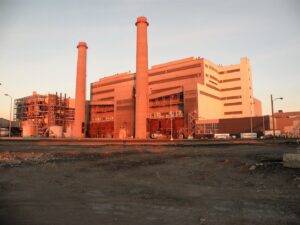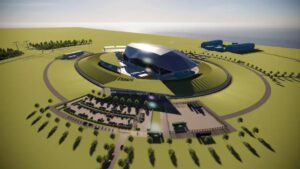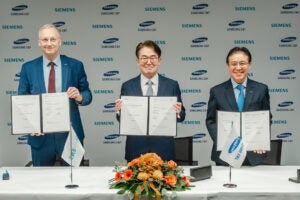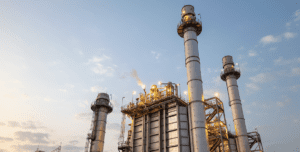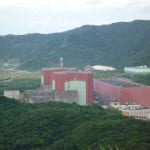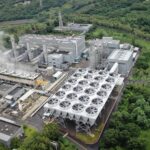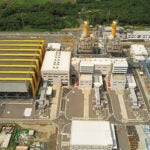
Taiwan is among several countries experiencing an energy crisis, with its supply of power struggling to keep up with demand from a rapidly growing high-tech sector. The country has long depended on imported fossil fuels, a situation at odds with some government officials and others who want the island to build more renewable energy. With demand for power outstripping supply, the country risks not only power shortages but also must weigh the economic impact to its commercial and industrial sectors.
The energy-intensive semiconductor industry is at the center of Taiwan business. Various organizations have said studies show Taiwan’s semiconductor industry will use twice as much electricity as all of New Zealand by 2030. Much of that energy is consumed by TSMC, or Taiwan Semiconductor Manufacturing Co., the largest company on the island and the world’s largest dedicated independent semiconductor group. Nvidia, the U.S.-based multinational artificial intelligence (AI) group, in May announced a deal to build a supercomputer with TSMC and Foxconn, the leading Taiwanese technology companies. President Trump in March called TSMC “the most powerful company in the world” when it was announced the group would invest another $100 billion into semiconductor chip manufacturing in the U.S.—touting five facilities in Arizona— bringing its total U.S. investment to $165 billion.
Leon Huang, CEO of China-based RapidDirect, a manufacturer supporting the semiconductor and energy sectors, told POWER: “Taiwan’s semiconductor sector is the backbone of its economy—and one of the most energy-intensive in the world. With data centers multiplying to support chip fabrication and AI workloads, Taiwan must treat power reliability as national infrastructure.” Part of that infrastructure is the need for more import terminals for liquefied natural gas (LNG). Taiwan imports LNG mostly from Australia, Qatar, and the U.S., via three terminals operated by state-owned China Petroleum Corp. (CPC). Government data shows Taiwan has nearly 22,000 MW of gas-fired power capacity fueled by LNG. Data also showed the 30-day moving average for Taiwan imports of LNG was at a record level in May.
 |
|
1. The Maanshan facility was Taiwan’s last operating nuclear power plant. Unit 2 at the site was shut down in May of this year, after Unit 1 was taken offline in 2024. Courtesy: Taipower |
The Taiwan Energy Administration, part of the country’s Ministry of Economic Affairs, in a recent report said the island imports about 97% of its energy supply, with those imports—nearly all oil, coal, and LNG—accounting for almost 90% of power generation. The country’s lone nuclear power plant, the 938-MW Unit 2 at Maanshan, closed on May 17, as its 40-year operating license expired. The closure of Maanshan (Figure 1) is part of the ruling Democratic Progressive Party’s promise of a “nuclear-free” Taiwan. Unit 1 (936-MW) at Maanshan was shut down last year, and Taiwan has closed six reactors in the past decade.
The Ministry of Economic Affairs has said gas-fired generation will be built to replace the lost nuclear output; analysts in the wake of the Maanshan closure said CPC already was looking to secure additional LNG shipments for delivery in July, August, and September, as more gas-fired generation prepares to come online. “This year, four large gas-fired units with a capacity of nearly 5 million kilowatts [5,000 MW], including Datan, Hsingda, and Taichung power plants, and about 3.5 million kilowatts [3,500 MW] of wind and photovoltaic power will join the power supply ranks, ensuring that the people have no worries about electricity,” the ministry said in a statement. The government has said it now targets an energy mix of 20% from renewable sources, 50% from LNG, and 30% from coal.
State-owned utility Taiwan Power Co., known as Taipower, in a filing in August 2024 said it expects to bring 14 new gas-fired units with total installed capacity of more than 13,000 MW online over the next few years. The expansion of the Datan gas-fired power plant in Taoyuan was completed last year, giving Datan nine combined-cycle generating units and about 7,500 MW of capacity. Datan at present is the world’s second-largest gas-fired power plant, behind only the 8,600-MW Dubai Jebel Ali Power and Desalination Plant in the United Arab Emirates. Taiwanese officials have said their country has the second-highest amount of gas-fired generation capacity either under construction or planned, behind only Vietnam.
Business leaders have said they welcome the new generation, though there remains concern about what will get built, and at what cost. “Taiwan’s government thinks there’s enough electricity [in 2025]. All we can do is believe them,” said Mark Liu, chairman of TSMC, at a shareholders’ meeting last year. The concern has been exacerbated by the phase-out of nuclear power, and the push for more renewable energy, which has been slowed by various issues. The government had said it wanted at least 5,700 MW of installed offshore wind capacity by 2025, but only 2,800 MW was installed at the end of last year, and only 1,600 MW was operational, according to the Bureau of Energy. Officials have blamed permitting issues for the shortfall. The agency also said onshore wind and solar power targets are not being met, with just 700 MW of onshore wind installed (out of a planned 1,200 MW). The government had targeted 20 GW of installed solar power capacity by year-end 2024, but just 12.5 GW of had been installed. Officials have said there’s a lack of available land for large-scale solar installations. There also have reportedly been problems with securing grid connections for renewable energy projects.
 |
|
2. The 5,500-MW Taichung Power Plant, which includes both coal- and gas-fired units, is expected to add at least four more gas-fired units in the coming years as the coal-burning boilers are shut down. Courtesy: Taipower |
Planned retirements of coal-fired generation also may be revisited if power problems persist. Taiwanese Premier Cho Jung-tai, in a visit to the 5,500-MW coal-fired Taichung Power Plant (Figure 2) last November, pledged that Taichung and all of Taiwan would be coal-free within a decade. The premier said four new gas-fired units will be in service at Taichung by 2032, joining four 70-MW gas turbines that have operated since 1990 at the site. The premier during his visit to Taichung said Taipower would set a goal to have a coal-free power supply by 2034, with coal-fired units only kept available as a backup power supply for national security. He said it aligns with the demand by Taichung City government officials for a one-for-one exchange of coal-fired units to gas-powered turbines.
Building more gas-fired generation capacity means Taiwan’s need for LNG is expected to rise significantly, up from 18 million metric tons a few years ago to 30 million metric tons by 2030. The reliance on LNG also must account for China’s activities in the waters around the island. China, which claims Taiwan—a self-governing democracy—as its own territory, has continually threatened to use force to take over the island. China regularly conducts air and sea military exercises around Taiwan. China in August 2022 during one of those exercises executed what was considered a quasi-blockade of the island, which raised concerns about the impact of a future, larger blockade by the Chinese.
Taiwan President Lai Ching-te in April said his country is prepared to increase its LNG imports from the U.S. to about 30% of the country’s total, up from its current 10%, as part of a broader trade deal. Lin Chia-lung, the country’s foreign minister, at a recent parliament meeting said, “We hope to take advantage of the huge U.S. market, their excellent technology capital and talent, to form a Taiwan-U.S. coalition, a joint fleet approach.”
Taiwan is looking at other power generation technologies. U.S. tech giant Google recently signed its first geothermal energy deal in Taiwan with geothermal energy developer Baseload Capital. The 10-MW project will supply local data centers and other facilities with electricity “while opening up pathways to scale geothermal development across the Asia-Pacific region and globally,” according to a news release. The Ministry of Economic Affairs said Taiwan has a target of adding 6 GW of geothermal power by 2050. The Google plant, which is expected online in 2029, would more than double the country’s current 7 MW of geothermal capacity, which is spread across five small plants. ThinkGeoEnergy, an Iceland-based geothermal group, said Taiwan—located along the so-called “Ring of Fire” tectonic plate—has an estimated geothermal energy potential of 30 GW to 60 GW. “This long-term partnership with Baseload Capital, which includes an equity investment in the company, represents our latest step to accelerate the deployment of geothermal as a 24/7 clean energy technology across Asia Pacific and globally,” Google said in a statement.
PEAK Wind in March announced that Fengmiao I, a 495-MW offshore wind farm, had reached financial close. The project is owned by Copenhagen Infrastructure Partners (CIP) through its fund Copenhagen Infrastructure V. PEAK Wind will manage the project. The company said it is the first offshore wind project in Taiwan to be supported by corporate power offtakers. Fengmiao I is CIP’s third offshore wind project in Taiwan. Construction of the wind farm, with a planned 33, 15-MW turbines, is expected to be complete by year-end 2027.
Meanwhile, all five projects awarded capacity in Taiwan’s Round 3.2 offshore wind tender have submitted contracts to the Ministry of Economic Affairs to initiate the signing process, according to a May 19 filing from the government agency. Grid connections for the projects, with a combined generation capacity of 2.7 GW, are planned between 2028 and 2030. Included in the tender is CIP’s 600-MW Fengmiao 2 project.
Billion Watts Technologies, the solar and energy storage subsidiary of Taiwan’s Billion Electric, in March announced completion of a 64-MW/262-MWh battery energy storage system (BESS) in central Taiwan, located in an industrial zone. The project was jointly developed with Shinshin Credit Corp., a Taiwan financial services group. Billion Watts in a statement said the BESS will be involved in energy shifting and frequency regulation, participating in Taipower’s E-dReg, or Enhanced Dynamic Regulation, ancillary services market. The project follows last year’s commissioning of a 120-MWh BESS for NHOA, an electric vehicle and energy storage company that is part of Taiwan Cement Corp. NHOA in late 2023 commissioned a 311-MWh BESS, currently the largest such system in Taiwan, that was “designed explicitly” for the E-dReg ancillary service market, according to NHOA.
Huang, whose RapidDirect company focuses on rapid prototyping and component production for data center cooling systems, along with hardware for wind and solar power, and other energy infrastructure equipment, said it’s important to recognize those energy storage projects. “A balanced mix of imported LNG, scaled renewables, and robust energy storage is critical. Offshore wind and solar must continue aggressively—but without storage, their intermittency won’t support semiconductor loads. A real breakthrough would be incentivizing co-location of renewables with industrial hubs and battery banks to offset peak demand.”
Huang, who has worked with clients across Asia, including in Taiwan, to address the accelerating energy demands of digital and industrial growth, said, “Taiwan has the engineering capability—it now needs policy alignment and investment in grid flexibility to secure its energy future.”
—Darrell Proctor is a senior editor for POWER.


